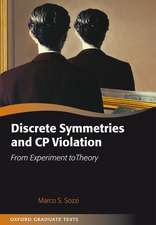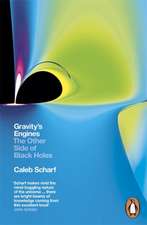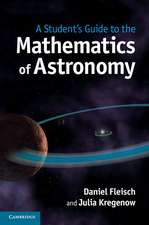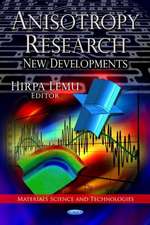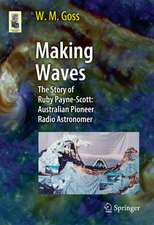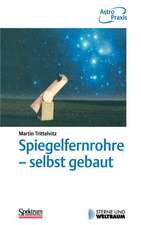The Black Hole-Neutron Star Binary Merger in Full General Relativity: Dependence on Neutron Star Equations of State: Springer Theses
Autor Koutarou Kyutokuen Limba Engleză Hardback – 11 ian 2013
Gravitational waves provide us with quantitative information on the neutron star compactness and equation of state via the cutoff frequency in the spectra, if tidal disruption of the neutron star occurs before the binary merges. The cutoff frequency will be observed by next-generation laser interferometric ground-based gravitational wave detectors, such as Advanced LIGO, Advanced VIRGO, and KAGRA.
The author has also determined that the mass of remnant disks are sufficient for the remnant black hole accretion disk to become a progenitor of short-hard gamma ray bursts accompanied by tidal disruptions and suggests that overspinning black holes may not be formed after the merger of even an extremely spinning black hole and an irrotational neutron star.
| Toate formatele și edițiile | Preț | Express |
|---|---|---|
| Paperback (1) | 635.31 lei 6-8 săpt. | |
| Springer – 25 iun 2015 | 635.31 lei 6-8 săpt. | |
| Hardback (1) | 640.88 lei 6-8 săpt. | |
| Springer – 11 ian 2013 | 640.88 lei 6-8 săpt. |
Din seria Springer Theses
- 18%
 Preț: 997.88 lei
Preț: 997.88 lei -
 Preț: 389.88 lei
Preț: 389.88 lei - 15%
 Preț: 646.94 lei
Preț: 646.94 lei - 18%
 Preț: 943.43 lei
Preț: 943.43 lei -
 Preț: 399.29 lei
Preț: 399.29 lei - 18%
 Preț: 944.99 lei
Preț: 944.99 lei - 15%
 Preț: 636.80 lei
Preț: 636.80 lei - 18%
 Preț: 941.05 lei
Preț: 941.05 lei - 15%
 Preț: 643.16 lei
Preț: 643.16 lei - 15%
 Preț: 642.68 lei
Preț: 642.68 lei - 18%
 Preț: 1103.62 lei
Preț: 1103.62 lei - 20%
 Preț: 558.83 lei
Preț: 558.83 lei - 18%
 Preț: 1112.30 lei
Preț: 1112.30 lei - 18%
 Preț: 944.19 lei
Preț: 944.19 lei - 18%
 Preț: 1109.92 lei
Preț: 1109.92 lei - 18%
 Preț: 1217.27 lei
Preț: 1217.27 lei - 15%
 Preț: 640.06 lei
Preț: 640.06 lei - 15%
 Preț: 636.45 lei
Preț: 636.45 lei - 15%
 Preț: 640.06 lei
Preț: 640.06 lei - 15%
 Preț: 640.88 lei
Preț: 640.88 lei -
 Preț: 389.70 lei
Preț: 389.70 lei - 20%
 Preț: 563.91 lei
Preț: 563.91 lei -
 Preț: 393.35 lei
Preț: 393.35 lei - 15%
 Preț: 637.93 lei
Preț: 637.93 lei - 15%
 Preț: 641.85 lei
Preț: 641.85 lei - 18%
 Preț: 1225.94 lei
Preț: 1225.94 lei - 20%
 Preț: 551.36 lei
Preț: 551.36 lei - 18%
 Preț: 1229.10 lei
Preț: 1229.10 lei - 15%
 Preț: 639.25 lei
Preț: 639.25 lei - 18%
 Preț: 999.45 lei
Preț: 999.45 lei - 15%
 Preț: 640.06 lei
Preț: 640.06 lei - 18%
 Preț: 1220.45 lei
Preț: 1220.45 lei - 18%
 Preț: 1116.26 lei
Preț: 1116.26 lei - 18%
 Preț: 1110.72 lei
Preț: 1110.72 lei - 18%
 Preț: 1000.87 lei
Preț: 1000.87 lei - 18%
 Preț: 891.17 lei
Preț: 891.17 lei - 15%
 Preț: 640.06 lei
Preț: 640.06 lei - 5%
 Preț: 1154.07 lei
Preț: 1154.07 lei - 15%
 Preț: 635.96 lei
Preț: 635.96 lei - 15%
 Preț: 640.88 lei
Preț: 640.88 lei -
 Preț: 387.20 lei
Preț: 387.20 lei - 18%
 Preț: 1109.92 lei
Preț: 1109.92 lei -
 Preț: 385.25 lei
Preț: 385.25 lei -
 Preț: 385.25 lei
Preț: 385.25 lei - 18%
 Preț: 1112.30 lei
Preț: 1112.30 lei - 18%
 Preț: 999.45 lei
Preț: 999.45 lei -
 Preț: 386.99 lei
Preț: 386.99 lei - 15%
 Preț: 637.13 lei
Preț: 637.13 lei - 20%
 Preț: 554.21 lei
Preț: 554.21 lei - 20%
 Preț: 555.59 lei
Preț: 555.59 lei
Preț: 640.88 lei
Preț vechi: 753.97 lei
-15% Nou
Puncte Express: 961
Preț estimativ în valută:
122.65€ • 127.57$ • 101.25£
122.65€ • 127.57$ • 101.25£
Carte tipărită la comandă
Livrare economică 12-26 aprilie
Preluare comenzi: 021 569.72.76
Specificații
ISBN-13: 9784431542001
ISBN-10: 4431542000
Pagini: 192
Ilustrații: XIII, 178 p.
Dimensiuni: 155 x 235 x 16 mm
Greutate: 0.43 kg
Ediția:2013
Editura: Springer
Colecția Springer
Seria Springer Theses
Locul publicării:Tokyo, Japan
ISBN-10: 4431542000
Pagini: 192
Ilustrații: XIII, 178 p.
Dimensiuni: 155 x 235 x 16 mm
Greutate: 0.43 kg
Ediția:2013
Editura: Springer
Colecția Springer
Seria Springer Theses
Locul publicării:Tokyo, Japan
Public țintă
ResearchCuprins
Equations of State of Neutron Star Matter.- Computing Initial Conditions.- Methods of Simulations.- Diagnostics for Numerical Simulations.- The Merger of Nonspinning Black Hole-Neutron Star Binaries.- The Merger of Spinning Black Hole-Neutron Star Binaries.
Notă biografică
Dr.Koutaro Kyutoku
Cosmophysics Group, Theory Center, IPNS (Institute of Particle and Nuclear Studies), KEK (High Energy Accelerator Research Organization)
kyutoku@post.kek.jp
Cosmophysics Group, Theory Center, IPNS (Institute of Particle and Nuclear Studies), KEK (High Energy Accelerator Research Organization)
kyutoku@post.kek.jp
Textul de pe ultima copertă
This thesis presents a systematic study of the orbital evolution, gravitational wave radiation, and merger remnant of the black hole–neutron star binary merger in full general relativity for the first time. Numerical-relativity simulations are performed using an adaptive mesh refinement code, SimulAtor for Compact objects in Relativistic Astrophysics (SACRA), which adopts a wide variety of zero-temperature equations of state for the neutron star matter.
Gravitational waves provide us with quantitative information on the neutron star compactness and equation of state via the cutoff frequency in the spectra, if tidal disruption of the neutron star occurs before the binary merges. The cutoff frequency will be observed by next-generation laser interferometric ground-based gravitational wave detectors, such as Advanced LIGO, Advanced VIRGO, and KAGRA.
The author has also determined that the mass of remnant disks are sufficient for the remnant black hole accretion disk to become a progenitor of short-hard gamma ray bursts accompanied by tidal disruptions and suggests that overspinning black holes may not be formed after the merger of even an extremely spinning black hole and an irrotational neutron star.
Gravitational waves provide us with quantitative information on the neutron star compactness and equation of state via the cutoff frequency in the spectra, if tidal disruption of the neutron star occurs before the binary merges. The cutoff frequency will be observed by next-generation laser interferometric ground-based gravitational wave detectors, such as Advanced LIGO, Advanced VIRGO, and KAGRA.
The author has also determined that the mass of remnant disks are sufficient for the remnant black hole accretion disk to become a progenitor of short-hard gamma ray bursts accompanied by tidal disruptions and suggests that overspinning black holes may not be formed after the merger of even an extremely spinning black hole and an irrotational neutron star.
Caracteristici
Derives relations between the gravitational wave cutoff frequency and neutron star compactness Clarifies formation of massive accretion disks for short-hard gamma ray bursts Nominated as an outstanding Ph.D thesis by Kyoto University’s Physics Department in 2012.


